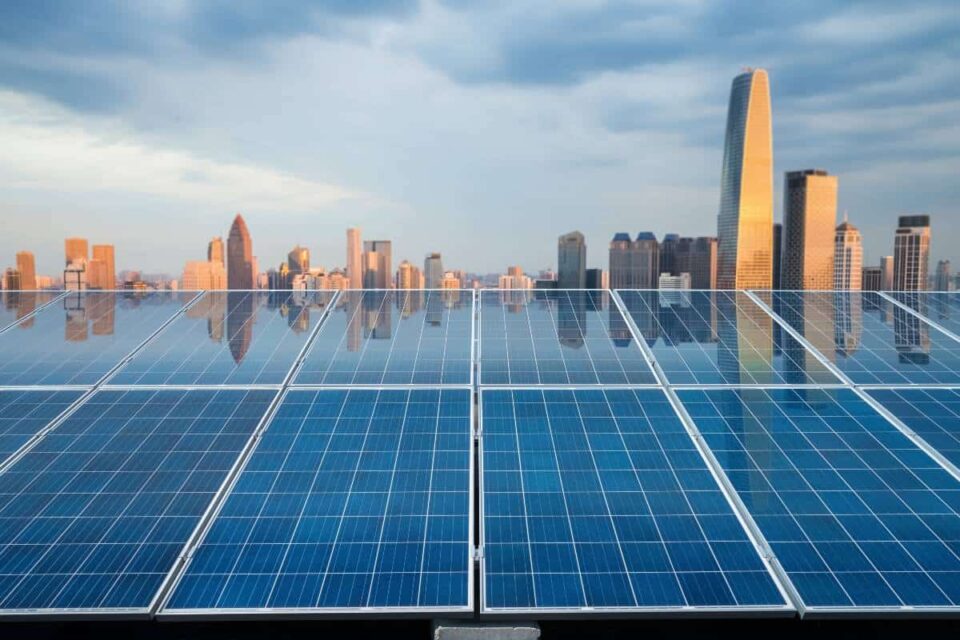It’s no secret that climate change is one of the most pressing issues facing our planet today. But, the majority of people don’t know just how significant commercial real estate can be in tackling carbon emissions! As a major consumer of finite energy resources such as electricity and natural gas, US commercial properties are responsible for 8.4% of all domestic GHG (greenhouse gas) emissions–second only to transportation.
Fortunately, there is a growing list of innovative strategies that real estate owners and operators can use to reduce carbon impact while also creating long-term cost savings. In this blog post, we’ll explore some simple approaches for decarbonizing commercial real estate and empowering businesses around the country to help lead us toward sustainable progress!
Worldwide, buildings are responsible for 37% of global carbon emissions and 34% of energy demand. Other environmental impacts of buildings include resource depletion, air, water, and land pollution, and biodiversity loss.
Key Takeaways
- Reducing carbon emissions in commercial real estate is essential to lessen its environmental impact and attain sustainability objectives. This would help combat climate change and promote a more eco-friendly future.
- To reduce carbon emissions in commercial real estate, there are diverse options such as enhancing energy efficiency, incorporating renewable energy sources, switching to electric systems, implementing smart building technologies, and utilizing sustainable construction methods.
- To achieve decarbonization, it is necessary to collaborate with various industries, have access to financial resources, increase education and awareness, and establish supportive policies and regulations in order to overcome obstacles.
Table of Contents

Current Challenges in Commercial Real Estate
High carbon emissions and their impact on the environment
Climate change poses various threats to real estate assets, including coastal properties getting swept away due to rising sea levels and energy bills increasing due to heat waves. Real estate investors often consider these physical risks, but they may not fully understand the challenges associated with the low-carbon transition.
The real estate industry produces nearly 40% of the world’s carbon dioxide emissions, of which 70% are generated by building operations and the remaining 30% by construction. To achieve significant reductions in emissions and meet global and national climate objectives, the real estate sector needs to make considerable changes to both its construction practices and operations.
There is a growing determination among governments, investors, and the public to achieve net-zero emissions by 2050 in order to limit global warming to 1.5˚ C above pre-industrial levels and minimize the negative impacts of climate change.
In order to reach a net zero goal, there are policies that may affect the real estate industry such as increasing carbon prices, implementing building and energy efficiency regulations, and mandating the use of renewable energy. It is worth noting that higher carbon prices can result in higher energy expenses and greater operating costs for physical properties.
To avoid limitations on renting or selling their property, owners may have to invest in meeting new energy efficiency standards. This could lead to outdated and high-emitting properties becoming less attractive due to the extra expenses involved.
In a study by the Bank of England, high-emitting properties saw reductions in value after climate policies were enacted. Real estate market actors from large institutional investors to homeowners are also expressing a preference for sustainable assets. These shifts both reflect concerns about high-emitting properties increasing costs and their diminished desirability among the climate-conscious.
Real estate investors have two main goals to achieve: generating profits and promoting the shift to low-carbon practices. To succeed, investors need to manage the risks posed by climate change and take advantage of opportunities in this area. Many investors are forming partnerships with providers of tools and data to help them achieve these objectives.
Regulatory pressures and evolving sustainability standards
The commercial real estate industry is increasingly focused on sustainability because HVAC, which represents 20% of operating and energy costs, can also account for 50% of total energy consumption in commercial offices.
Sustainability is not only beneficial for the environment but also for finances. According to 40% of real estate professionals, tenants are increasingly interested in sustainability. Moreover, sustainable buildings have the potential to attract better-quality tenants and increase rent by up to 10%.
Cost Implications and financial incentives for Decarbonization
Cost Implications
Capital Costs: Implementing decarbonization measures such as energy-efficient building systems, renewable energy installations, and energy storage systems may require upfront capital investments. These costs can vary depending on the size and complexity of the building and the chosen technologies.
Operational Costs: While decarbonization measures can lead to long-term cost savings through reduced energy consumption, there may be short-term operational costs associated with upgrading equipment, conducting energy audits, and implementing new processes.
Retrofitting Costs: Retrofitting existing buildings to improve energy efficiency and reduce carbon emissions can involve significant expenses. The costs will depend on the current condition of the building, the extent of retrofitting required, and the technologies adopted.
Maintenance and Monitoring Costs: Proper operation and maintenance of decarbonization technologies, such as renewable energy systems and energy management systems, may require additional resources and ongoing monitoring to ensure optimal performance.
Financial Incentives
Government Grants and Incentives: Many governments offer financial incentives, grants, and tax breaks to promote decarbonization in commercial real estate. These incentives can help offset the upfront costs and provide financial support for implementing energy-efficient technologies and renewable energy installations.
Energy Efficiency Programs: Utility companies and energy efficiency organizations often provide financial incentives and rebates for energy efficiency improvements. These programs can help cover a portion of the costs associated with energy audits, equipment upgrades, and energy-saving measures.
Please be aware that the financial incentives mentioned may not be available or may differ depending on the region and can also change over time. Therefore, building owners are advised to seek guidance from local authorities, energy agencies, and financial experts to accurately determine the costs and financial incentives applicable to their commercial real estate projects.
Key Strategies for Decarbonizing Commercial Real Estate
Decarbonizing commercial real estate involves implementing various strategies, with a strong focus on energy efficiency and building retrofits. Here are some key strategies for achieving decarbonization in commercial real estate:
Energy efficiency and building retrofits
To reduce carbon emissions in commercial buildings, it’s essential to improve energy efficiency. This can be done by implementing measures like:
- Upgrading lighting systems to energy-efficient LED technology.
- Installing smart building controls and automation systems to optimize energy use.
- Improving insulation and sealing to minimize heat loss or gain.
- Upgrading HVAC systems with high-efficiency equipment and implementing demand-controlled ventilation.
- Enhancing the efficiency of water heating systems.
- Implementing energy management systems to monitor and optimize energy consumption
Building Retrofits: Retrofitting existing buildings is a key strategy for decarbonization. This involves upgrading and improving building systems and components to enhance energy efficiency and reduce carbon emissions. Retrofit measures include:
- Replacing outdated or inefficient equipment with high-efficiency alternatives, such as boilers, chillers, and air conditioning units.
- Upgrading windows and doors to improve insulation and reduce heat transfer.
- Installing renewable energy systems, such as solar panels or geothermal heat pumps, to generate clean energy on-site.
- Implementing building envelope improvements, including roof insulation, wall insulation, and sealing air leaks.
- Integrating advanced energy management and control systems to optimize energy use and reduce waste.
Renewable energy adoption
Renewable Energy Integration: Incorporating renewable energy sources into commercial buildings is an effective strategy for decarbonization. This can involve:
- Installing solar photovoltaic (PV) systems on rooftops or open spaces to generate clean electricity.
- Utilizing wind turbines or geothermal systems for renewable power generation.
- Integrating energy storage systems to store excess renewable energy for later use or to provide backup power.
Electrification of heating and cooling systems
Transitioning from fossil fuel-based systems to electric alternatives is an important aspect of decarbonization. Strategies include:
- Electrifying heating and cooling systems by using electric heat pumps or district heating networks powered by renewable energy.
- Transitioning from fossil fuel-powered vehicles to electric vehicles (EVs) and providing EV charging infrastructure.
- Implementing advanced energy management systems to optimize energy use, monitor performance, and identify areas for improvement.
Smart building technologies and automation
Green building certifications, like LEED or BREEAM, offer a clear direction and acknowledgment for efforts to reduce carbon emissions. They establish sustainable guidelines and criteria for designing, constructing, and operating buildings.
Sustainable materials and construction practices
As we look to the future of commercial real estate, decarbonization continues to be a key focus. One promising avenue towards this goal is through sustainable materials and practices in construction. From energy-efficient insulation to renewable energy sources, there are countless ways to make commercial buildings more environmentally friendly.
If you are interested in learning about the impact of incorporating “green” initiatives in commercial real estate (CRE), I have a great article that you can read here. It delves deeper into the advantages of adopting eco-friendly practices in real estate and how it can help maximize ROI, drive tenant satisfaction and enhance long-term property value.
Benefits of Decarbonization in Commercial Real Estate
Environmental advantages and reduction of greenhouse gas emissions
As the world continues to grapple with the effects of climate change, the importance of decarbonization in commercial real estate cannot be overstated. By transitioning to cleaner, more sustainable energy sources, companies can reduce their carbon footprint and reduce the amount of global greenhouse gas emissions they emit into the atmosphere. The environmental benefits of this approach are clear, but there are also financial advantages to be gained. Studies have consistently shown that sustainable buildings are more attractive to investors and can command higher rental prices than their less-efficient counterparts.
Enhanced building performance and operational efficiency
As the push towards decarbonization gains momentum, commercial real estate stands to benefit significantly. One of the most prominent advantages is the enhanced building performance that results from decarbonizing operations. By implementing changes that reduce carbon emissions, property managers can optimize building systems and increase efficiency. This can lead to cost savings, improved tenant comfort, and a reduction in maintenance needs. Additionally, decarbonization promotes innovation as companies look for ways to meet emissions targets and stay ahead of the curve.
Improved tenant satisfaction and health outcomes
Reducing carbon emissions in commercial real estate can bring about a multitude of positive changes, one of which is improved tenant satisfaction and health outcomes. With decarbonization efforts, buildings can be retrofitted to offer cleaner air and ventilation systems, creating a healthier environment for occupants. This not only boosts tenant satisfaction but also leads to increased productivity and fewer sick days. In addition, reducing emissions can make a building more attractive to potential tenants who prioritize sustainability in their operations.
Long-term cost savings and increased property value
Decarbonization in commercial real estate has many benefits, including long-term cost savings and an increase in property value. By reducing carbon emissions through the use of clean energy sources and sustainability practices, owners and investors can experience significant financial gains. Additionally, decarbonization can attract environmentally conscious tenants and customers, improving the overall reputation and profitability of a property. As the world moves towards more eco-friendly practices, implementing decarbonization in commercial real estate is becoming increasingly important and effective.
Overcoming Barriers to Decarbonization
Financial Considerations and Access to Capital
Decarbonizing commercial real estate can be a daunting task, but it is an essential step toward building a sustainable and resilient future. A major barrier to achieving this goal is the financial considerations and access to capital. It is not uncommon for property owners to shy away from investing in energy-efficient upgrades due to the perceived high cost.
However, with the help of innovative financing models, such as energy service agreements and green leases, businesses can access the necessary capital for decarbonization projects without compromising their bottom line. Furthermore, these investments can lead to significant financial savings in the long run, lowering operating costs and enhancing asset value.
Education and awareness for industry stakeholders
As businesses, governments, and individuals begin to understand the importance of decarbonization and reducing our carbon footprint, industries must also take a closer look at the role they play. In the commercial real estate sector, stakeholders must be aware of the challenges that may arise when striving toward decarbonization.
These challenges may include a lack of infrastructure, access to funding, and limited technological solutions. However, by focusing on education and awareness, stakeholders can start to work towards innovative solutions that can overcome these barriers and push towards a more sustainable future.
Collaboration and partnerships for innovation
As the importance of decarbonization becomes increasingly evident, commercial real estate stakeholders face a number of barriers that make shifting towards more sustainable practices a formidable task. However, collaborating with partners who share a common vision can help overcome these obstacles. Innovative solutions can be developed through partnerships with companies that specialize in green technology or sustainability consulting. Such collaborations can result in the creation of new technologies, the establishment of best practices, and the sharing of knowledge and expertise.
Policy and regulatory support
Policy and regulatory support can help overcome these barriers and pave the way toward a sustainable future. With the right policies in place, businesses and building owners can be incentivized to invest in energy-efficient technologies and renewable energy sources. This will not only reduce their carbon footprint but also save them money in the long run. By working together, policymakers and industry leaders can make a real difference in the fight against climate change.
Case Studies and Success Stories
Salesforce Tower, San Francisco: The Salesforce Tower in San Francisco achieved LEED Platinum certification and became the tallest and largest net-zero energy commercial building in the United States. It incorporates various sustainable features such as high-performance glazing, energy-efficient systems, and rooftop solar panels to offset its energy consumption.
The Edge, Amsterdam: This innovative office building, known as “The Edge,” is considered one of the greenest buildings globally. It utilizes advanced technologies like smart sensors, energy-efficient LED lighting, and a sophisticated energy management system. It achieved a BREEAM Outstanding rating and showcases the potential for sustainable design in commercial real estate.
Empire State Building, New York City: The iconic Empire State Building underwent a comprehensive energy retrofit program that resulted in a 38% reduction in energy consumption. The retrofit included measures such as upgrading lighting systems, improving insulation, and installing high-efficiency chillers. It serves as an example of successful decarbonization in a historic building.
Future Outlook and Emerging Trends
Advancements in technology and their impact on decarbonization efforts
By utilizing data and technology systems to inform decision-making, organizations can effectively reduce their carbon emissions through cloud-based solutions.
It’s evident that various parties, such as investors, regulators, customers, and supply chain partners, are expecting organizations to be more transparent about their climate and sustainability initiatives. Business leaders are also seeking data of high quality and accuracy to monitor their carbon footprint, optimize the supply chain, and evaluate green revenue in real-time.
Nearly a third of 2,000 C-suite executives in 21 countries said the difficulty of measuring their organizations’ environmental impact is a significant barrier to these efforts, according to a Deloitte survey.
CIOs can assist their business counterparts in comprehending technologies and tactics that support sustainability objectives. Various modern technologies, such as big data analytics, advanced AI, IoT, edge computing, blockchain, distributed ledgers, cloud, and others, can be utilized to move towards low-carbon systems. Therefore, it is important how CIOs implement these technologies by working with other upper-level executives to promote a company’s sustainability agenda.
Policy Developments and the Role of Government in driving change
Bold policies that prioritize climate action are urgently needed to tackle the environmental crisis. These policies should clearly convey how citizens and the market can bring about significant change. However, such policies can only be successful if the government displays a strong political will, which is required to overcome opposition and build cross-sector support.
To promote the achievement of climate goals, policies like incentives and penalties motivate businesses to make investments and take part in economic activities that are in line with such objectives. A number of governments are discontinuing subsidies for fossil fuel industries as a move to quicken decarbonization efforts.
Many countries are using carbon taxes and emissions trading to make sure that the prices of products and services reflect the true cost of the natural resources they use and to encourage the use of renewable energy sources. Carbon taxes not only discourage carbon emissions but also generate extra income for governments.
The World Bank has reported that in 2021, there were 64 carbon pricing initiatives enacted globally, which apply to 45 different countries and territories, and cover approximately 21.5% of worldwide greenhouse gas emissions.
Anticipated challenges and opportunities for the commercial real estate sector
The world is currently dealing with the harmful impacts of a global pandemic and is facing another issue of climate change that is happening at a faster rate than previously estimated. According to a recent report from the Intergovernmental Panel on Climate Change, extreme weather conditions will become more frequent with a rise in temperatures.
According to the IPCC, in order to prevent the most severe predicted consequences and limit the global temperature increase to 1.5°C (or roughly 2.7°F), global carbon emissions need to decrease by 45% by 2030 and ultimately reach net zero by around 2050, taking the year 2010 as a baseline. However, the authors of the latest report warn that if CO2 emissions are not significantly reduced in the coming years, the Earth will reach this upper limit by 2040.
The authors have found that the trend can only be reversed by achieving net-zero global emissions by 2050, and this involves various challenges and opportunities for the commercial real estate sector. This industry is currently accountable for about 40% of all carbon emissions.

Decarbonizing Commercial Real Estate FAQs
How can barriers to decarbonization be overcome?
The commercial real estate industry faces obstacles to reducing carbon emissions, which include financial, legislative, and technological issues. Retrofitting existing buildings is expensive and requires significant up-front capital expenditure, making cost the primary financial barrier. Additionally, many countries lack regulations regarding the maximum allowable carbon emissions from buildings.
Are there any real-world success stories in decarbonizing commercial real estate?
Yes, there are a variety of successful initiatives from around the world that have achieved significant reductions in carbon emissions.
What are the emerging trends and future outlook for decarbonization in this sector?
The commercial real estate industry is increasingly focused on achieving net-zero emissions, with many governments promoting the switch to sustainable energy sources instead of relying on fossil fuels. Furthermore, energy-saving technology such as digital modeling, automation, and IoT is being used to lower energy usage and operating costs.
How can technology contribute to decarbonization efforts in commercial real estate?
Buildings’ carbon footprints can be decreased with the help of automation and energy management systems. These systems can regulate lighting, heating, and cooling based on factors such as occupancy and weather conditions.
What role do policies and regulations play in driving decarbonization?
Policies and regulations from the government play an important role in promoting decarbonization in the commercial real estate industry. To encourage the use of renewable energy sources and make sure that the prices of products and services reflect the true cost of natural resources, various countries have introduced carbon taxes and emissions trading systems.
Conclusion
In conclusion, commercial real estate has great potential to reduce its carbon emissions and advance the sustainability goals of any organization. As shown, there is no shortage when it comes to strategies that can be implemented for decarbonizing the sector. However, making the jump from theory to reality requires knowledgeable consultation and monitoring services.
At Toljcommercial, I provide a wide range of solutions tailored to fit your needs when it comes to advancing your sustainability objectives. I would love to discuss how we can best work together to benefit you and the environment. If you are looking for help in decarbonizing commercial real estate, why not call or schedule a free consultation with me today?




